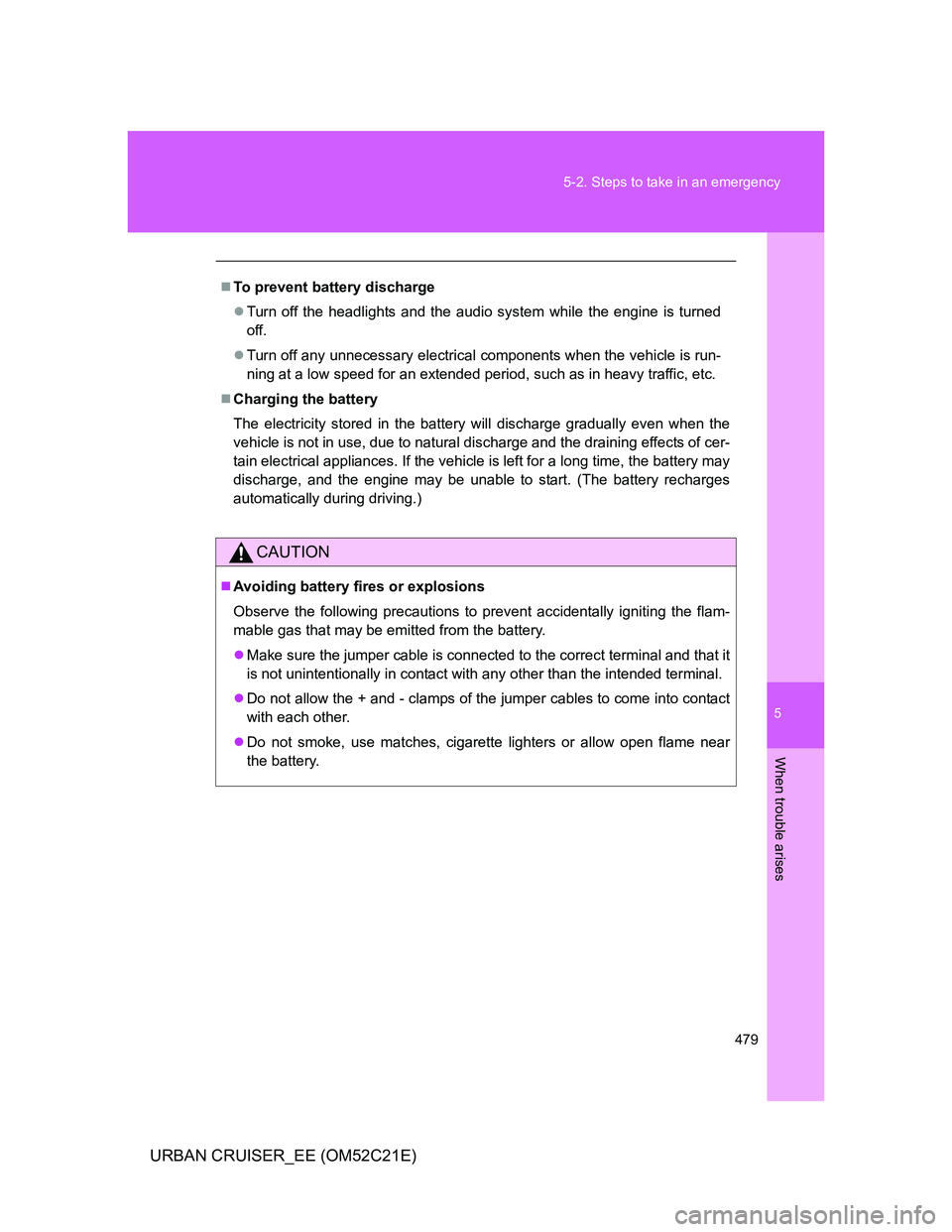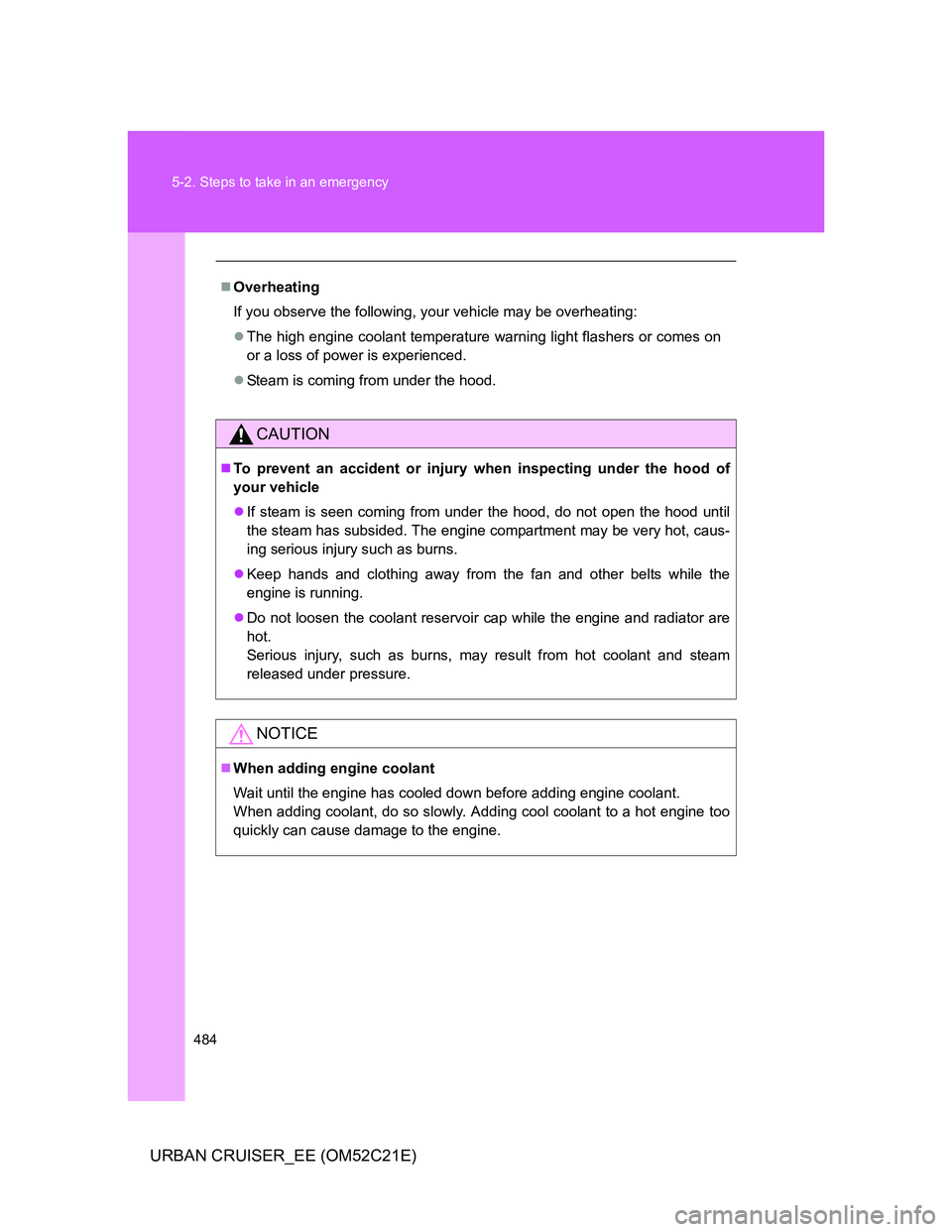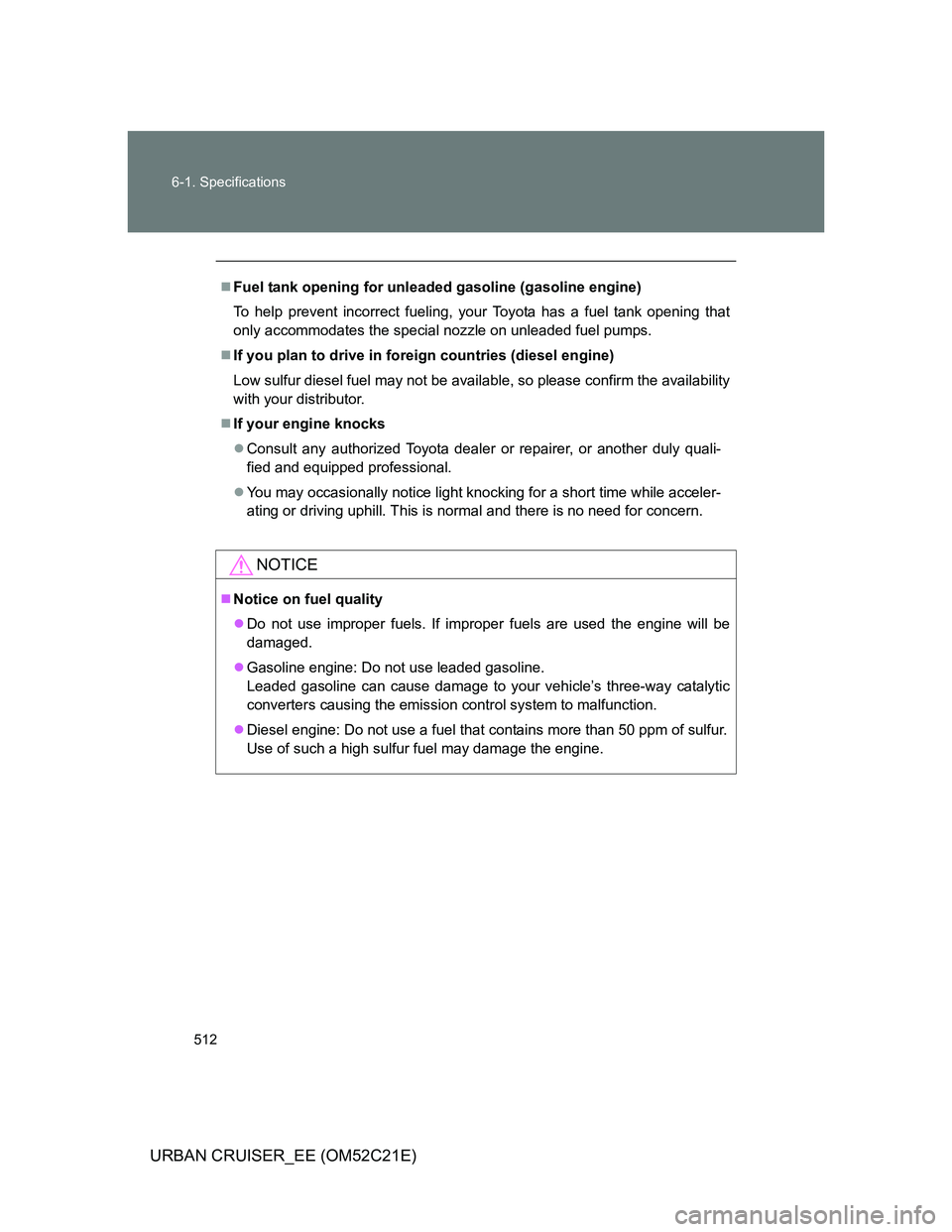Page 479 of 532

5
479 5-2. Steps to take in an emergency
When trouble arises
URBAN CRUISER_EE (OM52C21E)
To prevent battery discharge
Turn off the headlights and the audio system while the engine is turned
off.
Turn off any unnecessary electrical components when the vehicle is run-
ning at a low speed for an extended period, such as in heavy traffic, etc.
Charging the battery
The electricity stored in the battery will discharge gradually even when the
vehicle is not in use, due to natural discharge and the draining effects of cer-
tain electrical appliances. If the vehicle is left for a long time, the battery may
discharge, and the engine may be unable to start. (The battery recharges
automatically during driving.)
CAUTION
Avoiding battery fires or explosions
Observe the following precautions to prevent accidentally igniting the flam-
mable gas that may be emitted from the battery.
Make sure the jumper cable is connected to the correct terminal and that it
is not unintentionally in contact with any other than the intended terminal.
Do not allow the + and - clamps of the jumper cables to come into contact
with each other.
Do not smoke, use matches, cigarette lighters or allow open flame near
the battery.
Page 481 of 532
5
481
5-2. Steps to take in an emergency
When trouble arises
URBAN CRUISER_EE (OM52C21E)
If your vehicle overheats
If your engine overheats:
Stop the vehicle in a safe place and turn off the air condi-
tioning system.
Check to see if steam is coming out from under the hood.
If you see steam:
Stop the engine. Carefully lift the hood after the steam
subsides and then restart the engine.
If you do not see steam:
Leave the engine running and carefully lift the hood.
Check to see if the cooling fan is operating.
If the fan is operating:
Wait until the high engine coolant temperature warning
light goes off and then stop the engine.
If the fan is not operating:
Stop the engine and call any authorized Toyota dealer or
repairer, or another duly qualified and equipped profes-
sional.STEP1
STEP2
STEP3
Page 484 of 532

484 5-2. Steps to take in an emergency
URBAN CRUISER_EE (OM52C21E)
Overheating
If you observe the following, your vehicle may be overheating:
The high engine coolant temperature warning light flashers or comes on
or a loss of power is experienced.
Steam is coming from under the hood.
CAUTION
To prevent an accident or injury when inspecting under the hood of
your vehicle
If steam is seen coming from under the hood, do not open the hood until
the steam has subsided. The engine compartment may be very hot, caus-
ing serious injury such as burns.
Keep hands and clothing away from the fan and other belts while the
engine is running.
Do not loosen the coolant reservoir cap while the engine and radiator are
hot.
Serious injury, such as burns, may result from hot coolant and steam
released under pressure.
NOTICE
When adding engine coolant
Wait until the engine has cooled down before adding engine coolant.
When adding coolant, do so slowly. Adding cool coolant to a hot engine too
quickly can cause damage to the engine.
Page 486 of 532
486 5-2. Steps to take in an emergency
URBAN CRUISER_EE (OM52C21E)
Start the engine. (P. 179, 175)
If the engine does not start after the above steps have been per-
formed, wait for 10 seconds and try step 2 and 3 again. If the
engine still does not start, contact any authorized Toyota dealer or
repair, or another duly qualified and equipped professional.
Reinstall the cover.
Left-hand drive vehicles
Right-hand drive vehicles
After starting the engine, depress the accelerator pedal lightly until
the engine runs smoothly.
STEP4
STEP5
Page 510 of 532
510 6-1. Specifications
URBAN CRUISER_EE (OM52C21E)
Light bulbs
A: H4 halogen bulbs B: H11 halogen bulbs
C: Wedge base bulbs (amber) D: Wedge base bulbs (clear)
E: Double end bulbs
*: If equipped
Light BulbsWTy p e
ExteriorHeadlights 60/55 A
Front turn signal lights 21 C
Front position lights 5 D
Front fog lights
*55 B
Rear turn signal lights 21 C
Back-up lights 16 D
Rear fog lights
*21 D
Stop/tail lights 21/5 D
License plate lights 5 D
InteriorPersonal light 8 D
Interior light 8 E
Luggage compartment light 5 E
Page 512 of 532

512 6-1. Specifications
URBAN CRUISER_EE (OM52C21E)
Fuel tank opening for unleaded gasoline (gasoline engine)
To help prevent incorrect fueling, your Toyota has a fuel tank opening that
only accommodates the special nozzle on unleaded fuel pumps.
If you plan to drive in foreign countries (diesel engine)
Low sulfur diesel fuel may not be available, so please confirm the availability
with your distributor.
If your engine knocks
Consult any authorized Toyota dealer or repairer, or another duly quali-
fied and equipped professional.
You may occasionally notice light knocking for a short time while acceler-
ating or driving uphill. This is normal and there is no need for concern.
NOTICE
Notice on fuel quality
Do not use improper fuels. If improper fuels are used the engine will be
damaged.
Gasoline engine: Do not use leaded gasoline.
Leaded gasoline can cause damage to your vehicle’s three-way catalytic
converters causing the emission control system to malfunction.
Diesel engine: Do not use a fuel that contains more than 50 ppm of sulfur.
Use of such a high sulfur fuel may damage the engine.
Page 515 of 532
515 6-2. Customization
6
Vehicle specifications
URBAN CRUISER_EE (OM52C21E)
ItemFunctionDefault settingCustomized
setting
Illumination
(P. 320)Time elapsed before
lights turn off15 seconds7.5 seconds
30 seconds
Operation after the
“ENGINE START
STOP” switch is turned
offON OFF
Operation when the
doors are unlockedON OFF
Page 518 of 532
518
URBAN CRUISER_EE (OM52C21E)
Abbreviation list
Abbreviation/Acronym list
ABBREVIATIONSMEANING
2WD Two Wheel Drive
4WD Four Wheel Drive
ABS Anti-lock Brake System
ACC Accessory
CRS Child Restraint System
ECO Economy/Ecology
ELR Emergency Locking Retractor
EPS Electric Power Steering
GVM Gross Vehicle Mass
LED Light Emitting Diode
MPAC Maximum Permissible Axle Capacity
SRS Supplemental Restraint System
TRC Traction Control
TWI Treadwear Indicators
VIN Vehicle Identification Number
VSC Vehicle Stability Control